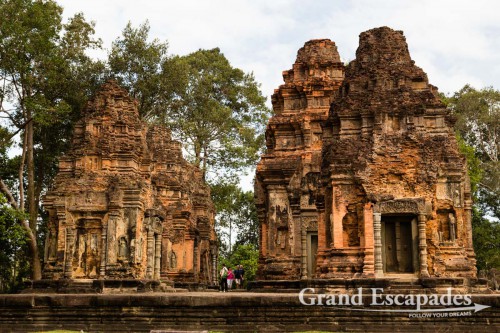After a long struggle with various vendors over who should get the business of selling us lunch, water, coconut etc… we distributed the business evenly among them. Heidi even bought some clothes, for the first time here, because the quality and design is usually not that grand here near Siem Reap.
Noodle soup and fried rice provided us with the energy to tackle the very last sightseeing during our week stay in Siem Reap, in which we only took 1.5 days off, actually sorting out more than 1.500 pictures and writing for the website. When we read about the Roluos group during our lunch break, we were almost faltering. But then, wandering around the three different sites, we were again inspired by the beauty, especially by the elaborate carvings.
What makes up the temples of today Ruluos was once the first capital of the Angkorian Era. It was built in the 9th century and is thus a lot older than the temples we previously visited. The main attraction is Bakong, which then was the state temple of the new Angkorian capital.
It was here that the first temple-mountain was constructed. Even today, stone lions guard the steep stairs at each level of the pyramid. The fourth level we found most interesting with 12 small intact shrines surrounding it. The sanctuary tower is on the last and 5th level. From there you have a great view of the entire complex.
Preah Ko, the very first temple built in Ruluos, was our next and very, very last stop. Despite the heat we could not escape the exquisiteness of its delicately carved lintels, especially the garlands with miniature horsemen emerging. Although we had seen zillions of carvings this week, we were still drawn in by them.
We did discover something new here, though. Most of the small tower had “blind doors”, called so because they were closed with bricks. After closing them with bricks, a layer of lime mortar was applied, into which carvings of most intricate patterns were chiseled.
For those who wonder about our sudden enthusiasm for ancient architecture… The answer is that we have never seen such a vast amount of temples, buildings, shrines, carvings in one area. So one question has been haunting us: how many people worked for how long to create all this?
Starting with transporting the large stones from distant quarries by elephants, chiseling the blocks to build temples and palaces etc… But the most amazing relics are the innumerous reliefs, carvings, sculptures that adorn the buildings. Not even our famous tour guide could answer this question!


No comments yet.